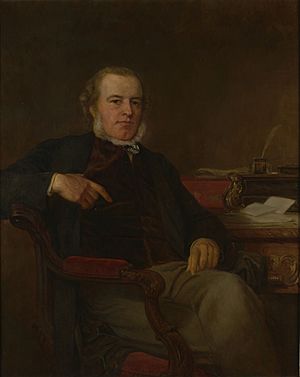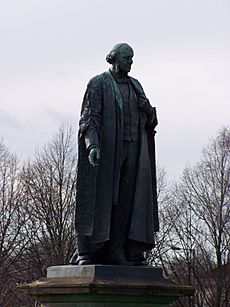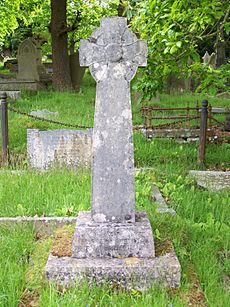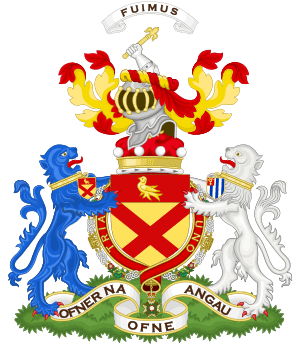Henry Bruce, 1st Baron Aberdare facts for kids
Quick facts for kids
The Lord Aberdare
|
|||||||||||||||||||||||||||||
|---|---|---|---|---|---|---|---|---|---|---|---|---|---|---|---|---|---|---|---|---|---|---|---|---|---|---|---|---|---|
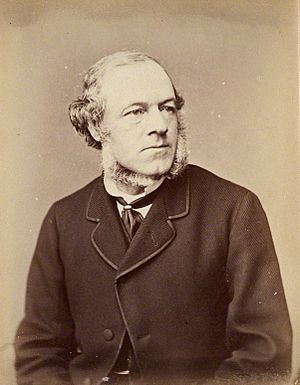 |
|||||||||||||||||||||||||||||
| Lord President of the Council | |||||||||||||||||||||||||||||
| In office 9 August 1873 – 21 February 1874 |
|||||||||||||||||||||||||||||
| Monarch | Queen Victoria | ||||||||||||||||||||||||||||
| Prime Minister | William Ewart Gladstone | ||||||||||||||||||||||||||||
| Preceded by | The Earl de Grey and Ripon | ||||||||||||||||||||||||||||
| Succeeded by | The Duke of Richmond | ||||||||||||||||||||||||||||
| Home Secretary | |||||||||||||||||||||||||||||
| In office 9 December 1868 – 9 August 1873 |
|||||||||||||||||||||||||||||
| Monarch | Queen Victoria | ||||||||||||||||||||||||||||
| Prime Minister | William Ewart Gladstone | ||||||||||||||||||||||||||||
| Preceded by | Gathorne Hardy | ||||||||||||||||||||||||||||
| Succeeded by | Robert Lowe | ||||||||||||||||||||||||||||
| Vice-President of the Committee of the Council on Education | |||||||||||||||||||||||||||||
| In office 26 April 1864 – 26 June 1866 |
|||||||||||||||||||||||||||||
| Monarch | Queen Victoria | ||||||||||||||||||||||||||||
| Prime Minister | The Viscount Palmerston The Earl Russel |
||||||||||||||||||||||||||||
| Preceded by | Robert Lowe | ||||||||||||||||||||||||||||
| Succeeded by | Henry Lowry-Corry | ||||||||||||||||||||||||||||
| Parliamentary Under-Secretary of state for Home Affairs | |||||||||||||||||||||||||||||
| In office 14 November 1862 – 25 April 1864 |
|||||||||||||||||||||||||||||
| Monarch | Queen Victoria | ||||||||||||||||||||||||||||
| Prime Minister | The Viscount Palmerston | ||||||||||||||||||||||||||||
| Preceded by | George Clive | ||||||||||||||||||||||||||||
| Succeeded by | Thomas Baring | ||||||||||||||||||||||||||||
|
|||||||||||||||||||||||||||||
| Personal details | |||||||||||||||||||||||||||||
| Born |
Henry Austin Bruce
16 April 1815 Aberdare, Glamorganshire |
||||||||||||||||||||||||||||
| Died | 25 February 1895 (aged 79) South Kensington, London |
||||||||||||||||||||||||||||
| Resting place | Aberffrwd Cemetery, Mountain Ash | ||||||||||||||||||||||||||||
| Political party | Liberal | ||||||||||||||||||||||||||||
| Spouses |
Annabella Beadon
(m. 1846; died 1852)Norah Napier
(m. 1854) |
||||||||||||||||||||||||||||
| Education | Swansea Grammar School | ||||||||||||||||||||||||||||
| Alma mater | Lincoln's Inn | ||||||||||||||||||||||||||||
Henry Austin Bruce, also known as the 1st Baron Aberdare, was an important British politician. He was born on April 16, 1815, and passed away on February 25, 1895. He was a member of the Liberal Party. He held key government jobs, including being the Home Secretary from 1868 to 1873. This role was like being in charge of law and order in the country. He also served as the Lord President of the Council, which was another high-ranking government position.
Contents
Early Life and Education
Henry Bruce was born in a place called Duffryn, Aberdare, in Glamorganshire, Wales. His father, John Bruce, was a landowner in the area. Henry's family became very wealthy when coal was discovered under their land.
From the age of twelve, Henry went to Swansea Grammar School. Later, in 1837, he became a barrister, which is a type of lawyer. From 1847 to 1854, he worked as a special judge for Merthyr Tydfil and Aberdare. He left this job when he became a Member of Parliament.
Political Career Begins (1852–1868)
In December 1852, Henry Bruce became a Member of Parliament (MP) for Merthyr Tydfil. He was supported by powerful iron factory owners. Even so, he often supported new and fair policies, except for secret voting.
However, his relationship with coal miners in the Aberdare Valley became difficult. This happened during a big strike in 1857–1858. Bruce tried to calm the miners, but he also spoke strongly against trade unions. This made him unpopular and might have led to his election loss later.
In 1862, after almost ten years as an MP, he became the Under-Secretary of State for the Home Department. This was a junior role in the Home Office. In 1864, he became a Privy Councillor and was promoted to Vice-President of the Council of Education.
The 1868 Election Challenge
In the 1868 general election, the Merthyr Tydfil area changed. More people could vote, especially miners in the Aberdare Valley. Many of these new voters did not like Bruce because of his actions during the 1857–58 strike.
Another Liberal candidate, Henry Richard, who was very popular, also ran. This made it harder for Bruce. In the end, he lost his seat and finished third in the election.
Key Government Roles (1869–1874)
After losing his seat in Merthyr Tydfil, Bruce was quickly elected as an MP for Renfrewshire in 1869. Soon after, William Ewart Gladstone, the Prime Minister, made him the Home Secretary. This was a very important job, overseeing law and order in the country.
During his time as Home Secretary, he worked on new laws about alcohol. He was responsible for the Licensing Act 1872. This law gave local judges more power over who could sell alcohol. It also made rules about how long pubs could stay open.
In 1873, Bruce left the Home Secretary role to become the Lord President of the Council. This was another high-ranking position. At this time, he was also given a special title and became a Lord, known as Baron Aberdare.
Focus on Education and Social Issues
After the Liberal government lost power in 1874, Lord Aberdare focused on social and educational issues. He was very interested in improving education in Wales. In 1880, he led a committee that looked into education in Wales. Their report led to the Welsh Intermediate Education Act 1889, which helped create more schools.
Lord Aberdare also helped set up University College of South Wales and Monmouthshire in 1883, becoming its first president. He believed that Wales needed its own university. This dream came true in 1893 when the University of Wales was founded, and Lord Aberdare became its first leader.
He was also involved in many important groups. He became a Fellow of the Royal Society in 1876. He was president of the Royal Historical Society and the Royal Geographical Society. He also led the Girls' Day School Trust, which helped provide education for girls.
Work in West Africa
In 1882, Lord Aberdare became involved with West Africa. He became the chairman of the National African Company. This company later became the Royal Niger Company in 1886. This company played a big role in the history of Nigeria.
Family Life
Henry Bruce married Annabella Beadon in 1846. They had one son and three daughters. After Annabella passed away in 1852, he married Norah Creina Blanche Napier in 1854. Norah was the daughter of a famous historian, Sir William Napier.
With Norah, he had seven daughters and two sons. One of their sons, Charles Granville Bruce, became a famous mountaineer. Their daughter, Alice Bruce, was a leader in women's education. Another daughter, Sarah, married a barrister named Montague Muir Mackenzie.
Lord Aberdare passed away in London on February 25, 1895, at the age of 79. His son from his first marriage, Henry, became the next Baron Aberdare. His wife, Lady Aberdare, was also very active in promoting women's education and helped establish Aberdare Hall in Cardiff.
Memorial
Henry Austin Bruce is buried at Aberffrwd Cemetery in Mountain Ash, Wales. His grave is marked by a simple Celtic cross.
Images for kids
-
Headstone of Sarah Fox Matheson, née Bruce (1861–1935), in Headington Cemetery, Oxford


